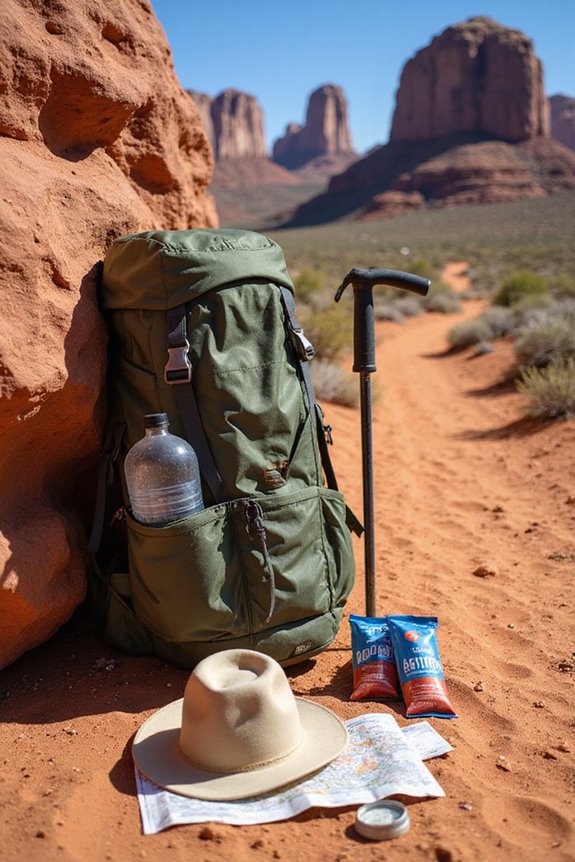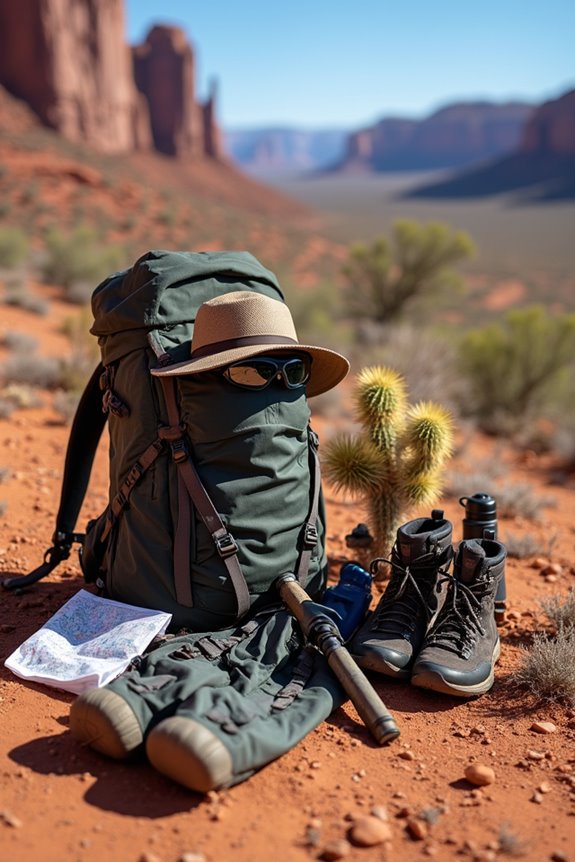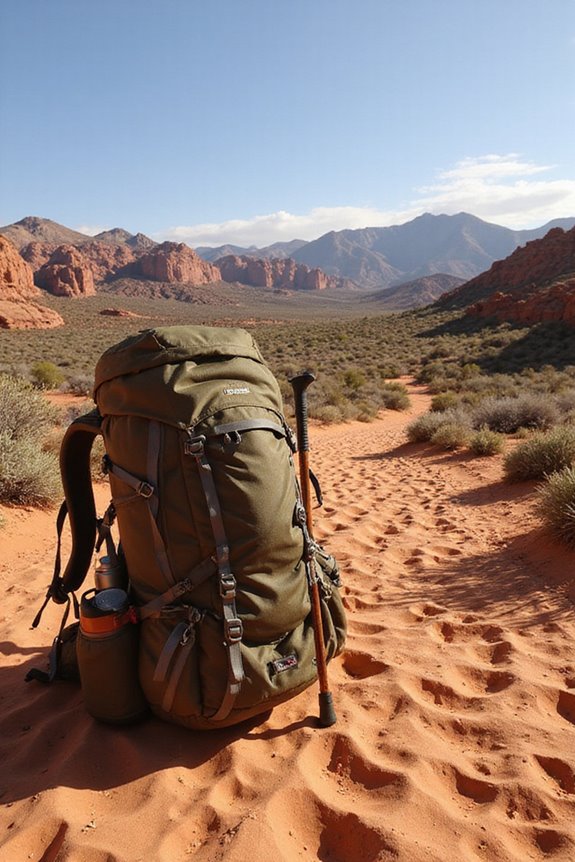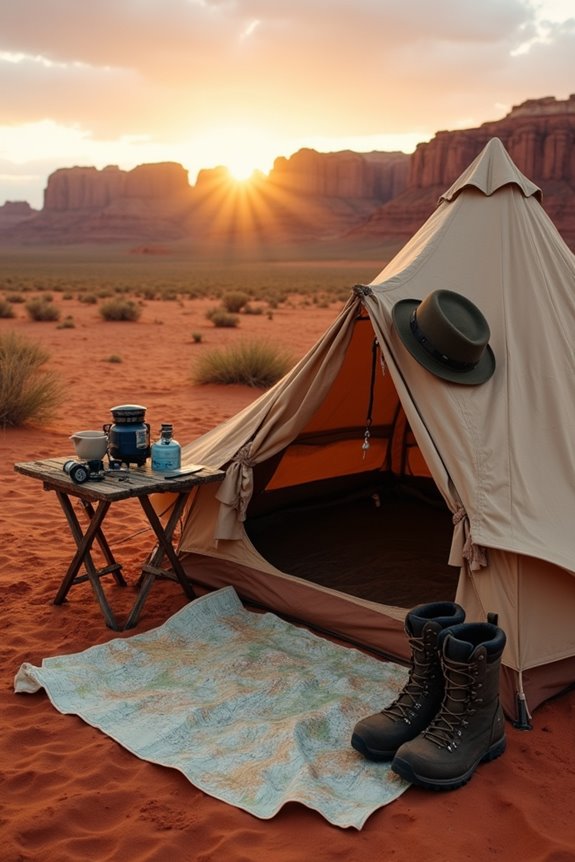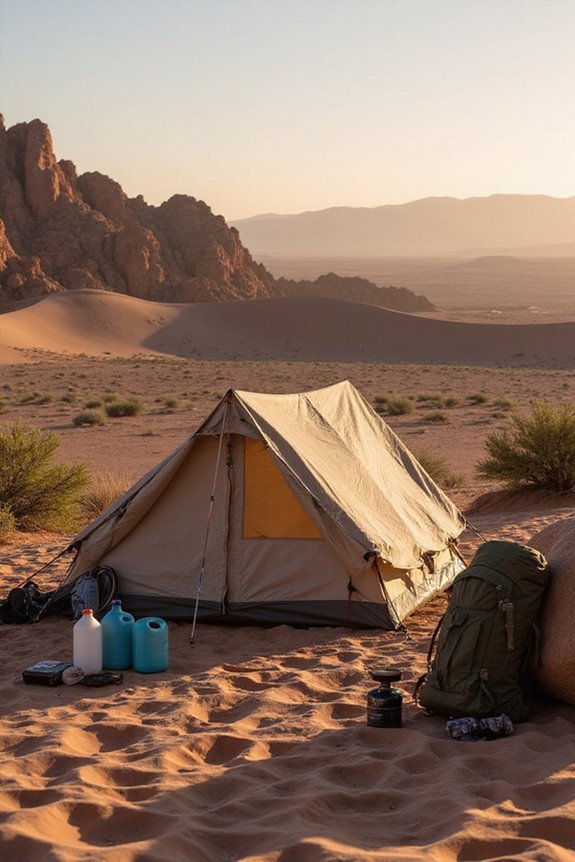When we tackle desert hiking, it’s all about hydration and smart packing! Let’s aim for 7 to 10 ounces of water every 10 to 20 minutes—yes, even before we feel thirsty! A good tip? Wear light, breathable clothing and slap on that sunscreen. Keep an eye on the weather forecast, and opt for early morning hikes to dodge the heat. And trust me, knowing the local wildlife is a game changer! Stick around, and we’ll share even more essential survival tips for your adventure!
Key Takeaways
- Proactive hydration is essential; drink 7 to 10 ounces every 10 to 20 minutes, even before feeling thirsty.
- Dress in lightweight, breathable clothing and opt for light colors to reflect sun rays and stay cool.
- Plan hikes during early mornings or late afternoons to avoid extreme heat and direct sunlight.
- Equip yourself with a reliable GPS device and familiarize yourself with the terrain using topographic maps for navigation.
- Be aware of local wildlife; hike in small groups and stick to marked trails to ensure safety and protect ecosystems.
Hydration and Water Management
When it comes to desert hiking, staying hydrated is absolutely essential—trust me, you don’t want to end up like a sun-dried tomato! We need to focus on our water consumption, aiming for 7 to 10 ounces every 10 to 20 minutes. It’s not just about drinking when we’re thirsty; proactive hydration is key! Use clever hydration techniques like tracking with marked bottles or tally systems. Invest in a leak-proof design water bottle with sufficient capacity to ensure you have enough water for the duration of your hike.
Be sure we’re balancing our electrolytes, too; consider snacking on fruits like watermelon and oranges—they’re our hydration allies! Let’s not forget hydration frequency; we should drink at water refill points to lighten our load. Keep an eye out for dehydration symptoms, and remember, solid nutrition strategies help maintain our energy for those epic desert adventures!
Navigation and Trail Safety
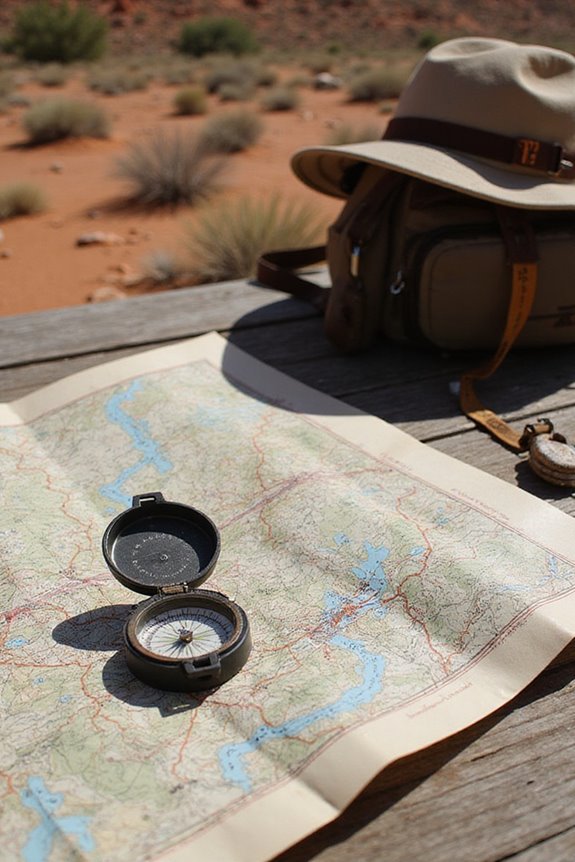
Maneuvering the vast, sun-soaked wilderness of the desert can feel like a thrilling treasure hunt, but without the right tools and techniques, we might just end up wandering in circles like lost tumbleweeds! Let’s equip ourselves with essential compass skills and map reading techniques to navigate confidently. Trust me, getting to know those topographic maps beforehand is like having an adventure cheat sheet!
Don’t forget a reliable GPS device for when the landmarks play hide-and-seek. Consider models like the Garmin eTrex 32x which features sunlight-readable displays ideal for harsh desert conditions. While we love offline map apps, we shouldn’t let them spoil our natural navigation instincts! As we hike, let’s keep an eye on cairns—those trusty rock stacks that guide our journey. Together, we’ll embrace the freedom of the desert, all while being smart and safe!
Clothing and Sun Protection
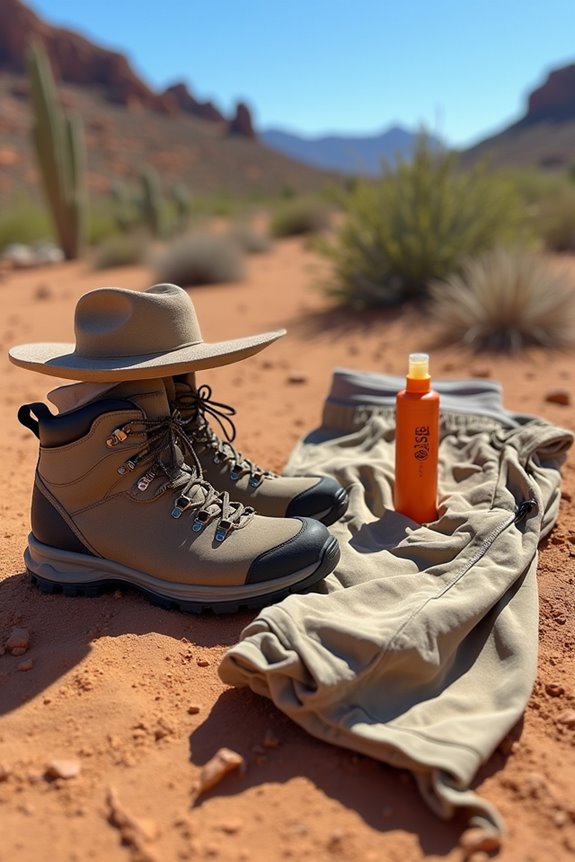
After ensuring we’re on the right path with our navigation skills, let’s get ready to tackle one of the most essential aspects of desert hiking: what we wear and how we protect ourselves from that relentless sun. Choosing the right fabric is key! Lightweight, breathable materials like polyester blends and nylon keep us cool, while light colors reflect that blazing sun. Trust me, we don’t want cotton clinging to us like a bad relationship. Long sleeves and wide-brimmed hats are our friends—they shield us from harsh rays and pesky critters. Plus, don’t forget your sunglasses! Zip-off pants offer ultimate versatility for desert hiking, allowing quick adaptation to temperature changes throughout the day without carrying extra clothing. With solid sun safety in mind, we can stay fresh and energized on the trail, ready for every adventure the desert throws our way.
Weather Awareness and Timing
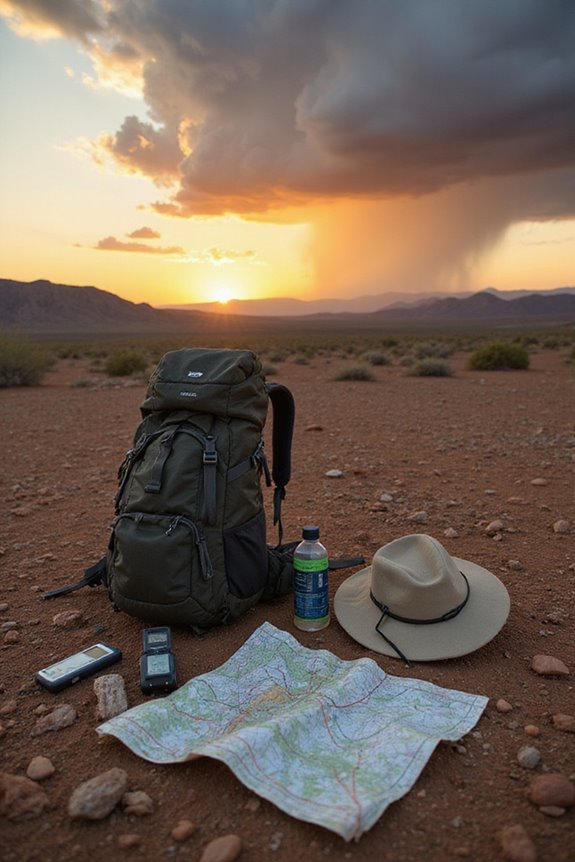
As we gear up for our desert hiking adventures, being aware of the weather and timing can make all the difference! It’s understood that summer’s sweltering days can soar from 80°F to 115°F, and that’s no fun for anyone. Instead, let’s embrace fall, winter, and spring when temps are a delightful 60-75°F.
When planning our hikes, early mornings and late afternoons are our best buddies—avoiding the scorching sun from 10 am to 4 pm is key. Remember, sudden temperature fluctuations can surprise us, so keeping an eye on weather forecasting helps. Having quick-dry clothing with breathable fabric is essential for managing the dramatic temperature changes common in desert environments. Let’s strap on our adventure boots and chase that freedom while staying smart about our timing in the wilderness!
Terrain Hazards and Equipment
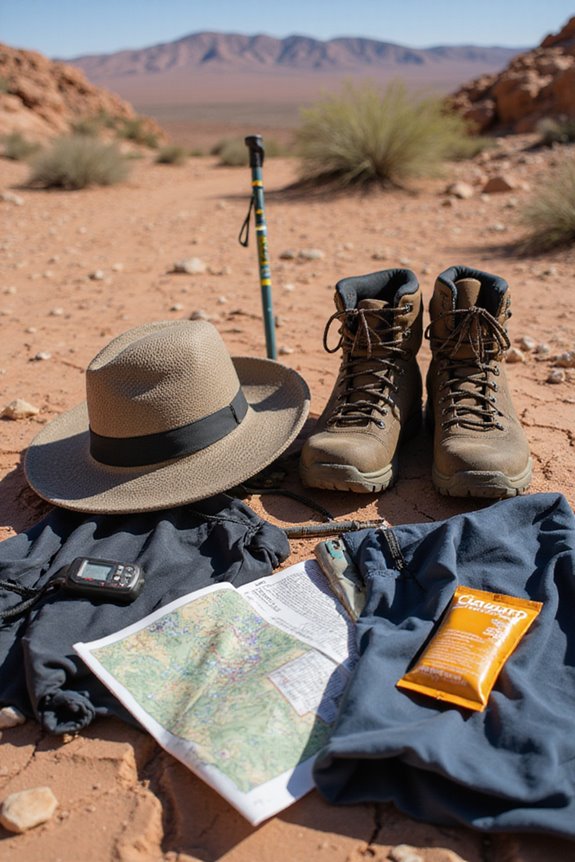
When it comes to tackling desert trails, we’re not just enjoying the scenery—it’s all about staying smart and safe too! Those rocky paths can be tricky, so proper footwear selection is essential. We need sturdy shoes with strong traction to give us stability on loose sand and gravel while preventing slips. Trust me, no one wants to be that hiker taking a tumble!
Remember to keep an eye out for sharp cacti and hidden drop-offs—nobody wants an unexpected souvenir from their adventure. By mastering traction techniques like using hiking poles, we can navigate those tricky sections more confidently. Boots with multi-directional tread patterns provide exceptional stability on unpredictable desert terrain. Let’s embrace the freedom of the wild while remaining aware of our surroundings and equipped with the right gear. Happy hiking!
Wildlife and Environmental Considerations
While exploring the vast beauty of desert trails, we can’t forget about the incredible wildlife that shares this landscape with us! It’s important to practice wildlife preparedness. We should research local species before our adventure so we can anticipate behaviors and risk levels. Hiking in small groups not only enhances our experience but also reduces the allure for predators.
Let’s respect our surroundings by minimizing our environmental impact. Stick to marked trails to protect fragile flora and fauna. Remember, leaving no trace means packing out everything, including crumbs! By being mindful and aware, we can enjoy the freedom of the desert while ensuring our safety and that of its wildlife. Happy trails!
Essential First Aid for Desert Hiking
Heading out into the desert means we need to be ready for anything—even the unexpected little scrapes and bumps along the way! For high-quality wound care, let’s pack assorted adhesive bandages, blister treatments like KT Tape, and antiseptic wipes. Keeping these handy helps with injury prevention and reduces infection risks.
Don’t forget sterile gauze for those larger cuts and pain relievers like ibuprofen to keep us moving. And let’s not ignore prevention; early treatment of hot spots guarantees we avoid painful blisters! We should also have a pocket wilderness first aid guide and improvise with what we have—tree branches make surprisingly great splints. Remember, staying hydrated is key, so let’s drink up and have fun out there!
Frequently Asked Questions
What Are the Best Times of Year for Desert Hiking?
When we consider the best hiking months, spring and fall shine with pleasant temperatures and manageable weather. Embracing these seasonal shifts lets us explore the beauty of deserts without facing extreme heat or cold.
How Do I Recognize Signs of Heat Exhaustion?
We’ve got to recognize heat exhaustion symptoms early. Feeling dizzy or fatigued? Let’s prioritize hydration strategies—sip water often and replenish electrolytes. Staying aware can keep us enjoying our adventures without risking our well-being.
Can I Find Water Sources While Hiking in the Desert?
While we roam the sun-kissed landscape, finding natural springs is like chasing mirages—elusive but possible. Our desert hydration tips remind us to pack extra water, being prepared stirs the freedom within our adventurous spirits.
What Should I Do if I Get Lost in the Desert?
If we ever get lost in the desert, let’s stay calm and use our navigation techniques and survival kits. We should mark our location, stay put, and signal for help while conserving our energy.
Are There Specific Permits Required for Desert Hiking?
When it comes to desert hiking, we should consider permit types and hiking regulations carefully. While day hikes often need no permits, overnight adventures usually require them, so let’s plan ahead for a hassle-free experience.

